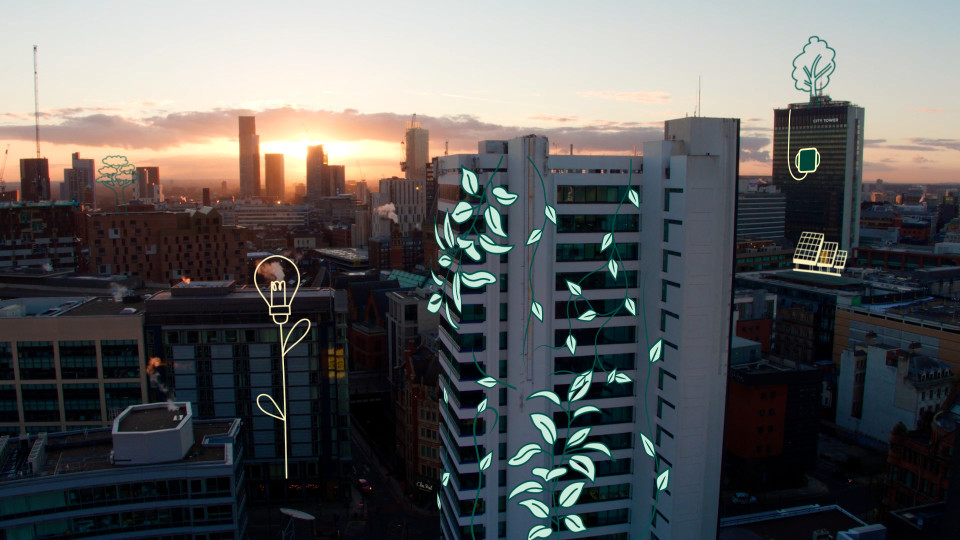Bruntwood's building efficiency programme - A Q&A with Alex Edwards
By Bruntwood

Imagine what 2050 looks like. Will it be hotter? Most definitely - and probably not the pleasant kind of hot. Will there be futuristic hovercrafts that we see in the movies? Perhaps.
However, amongst a wave of change, there are some things that will remain a constant. Buildings.
The UK Green Building Council estimates that approximately 80% of buildings that exist today will still be here in 2050.
So as well as creating new, sustainable buildings, we need to make changes to our existing ones in order to make them more efficient. This process of change is called ‘retrofitting’ - and we must find a way to do it successfully to have a chance of meeting future energy reduction targets.
In November 2022, we sat down with Alex Edwards, Bruntwood’s Sustainability Director, to discuss how Bruntwood is ahead of the curve in adapting to what’s to come.
What was your first step in making our buildings fit for the future?
To create thriving cities, we have to produce highly efficient buildings to help our communities to prosper. To reach that goal, we know that we need to put a lot of focus into adapting our existing buildings as well as developing the best new sustainable workspaces in the UK.
Starting in 2021, I led a project team from across the Bruntwood Group to understand what is needed to elevate our current portfolio to reach an EPC B rating by 2030, as part of a broader goal to make all of our buildings net zero carbon by 2050.
The project was called the Building Efficiency Programme.
What were the first steps of the Programme?
We didn’t know it at the time, but the first step was the Sustainability Pilot we completed at Trafford House in early 2021, with the support of external consultant, Ramboll. We set out to understand what we needed to do at the building to reduce energy consumption in line with future net zero standards and shortly after completion I was asked to lead the Building Efficiency Programme.
We’d spent lots of time on the Trafford House Sustainability Pilot and were really happy with the results, but it took many months to complete and needed an external consultant to write the report. So I needed to work out a methodology to obtain the same results for over 100 buildings in less than 12 months - a huge challenge.
The proposal was to instruct four external consultants to complete 17 energy assessments of different buildings. Buildings were selected as a good representation of the portfolio considering things like building age, HVAC system and use type, with lab buildings at Alderley Park selected as well as office buildings.
Once the 17 energy assessments were completed we then extrapolated the results to the remainder of our portfolio using a process called categorisation - grouping building features together based on certain similarities. For example, by improving single glazed windows to double glazed windows, we could expect to see a similar impact across our buildings.
What are the results?
We now have a really good understanding of our buildings across both Bruntwood SciTech and Bruntwood Works portfolios.
We know which interventions are needed for every single one of our buildings to raise them to an EPC B rating by 2030 - a fantastic achievement that, as far as we know, hasn’t yet been replicated in the UK commercial property industry (as of January 2023).
The primary intervention we need to make is the introduction of thermally efficient building fabric - in particular, high performance facade and air tightness, LED lighting and replacing gas boilers with heat pumps.
Laboratories are well known for being unsustainable. However, we know that by making our HVAC systems more efficient, we can create major improvements in our laboratory buildings, too.
What’s next?
Now that the first part of the Building Efficiency Programme is complete, our main action is to support our asset management colleagues to create a bespoke net zero plan for each building.
From there, we’ll identify when, where and how changes should be made along a timeline that takes us to 2030.
Are you excited or daunted about the future?
It will be a significant challenge, but I’m excited about Bruntwood continuing to lead the way in sustainable buildings.
I think the link with our Smart Building programme is key, as in my opinion, smart solutions and net zero carbon go hand-in-hand. I'm most looking forward to seeing us deliver a building that’s net zero carbon in operation from one of our older, inefficient assets like Pall Mall.
Our work in the coming years will add to our recent successes - having won the Commercial Developer of the Year Award 2022 and Recycled/Refurbished Workspace of the Year for Bloc.
Stay Connected!
Sign up to our newsletter for the latest news, updates and offers.